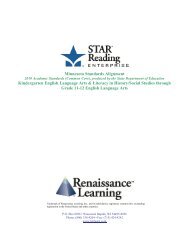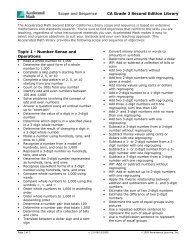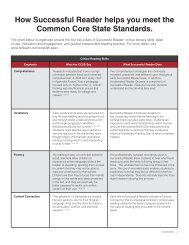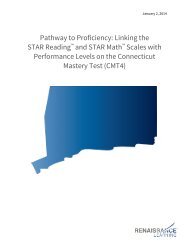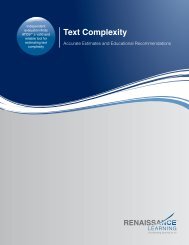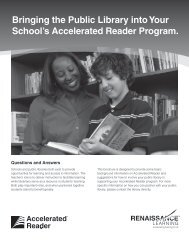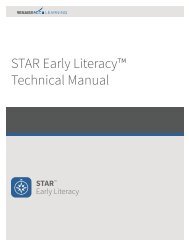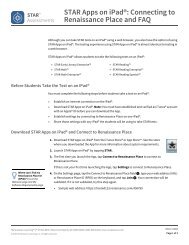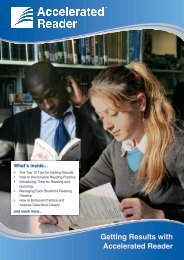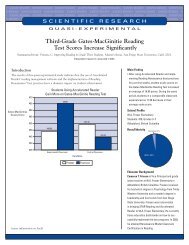New Thinking in Response to Intervention - Renaissance Learning
New Thinking in Response to Intervention - Renaissance Learning
New Thinking in Response to Intervention - Renaissance Learning
Create successful ePaper yourself
Turn your PDF publications into a flip-book with our unique Google optimized e-Paper software.
Introduction<br />
Over the past few years, there has been <strong>in</strong>creas<strong>in</strong>g <strong>in</strong>terest <strong>in</strong> the process known as <strong>Response</strong> <strong>to</strong> <strong>Intervention</strong><br />
(RTI) with<strong>in</strong> the education community. RTI is a multi-tiered system of supports that organizes services <strong>to</strong> all<br />
students <strong>in</strong> an effort <strong>to</strong> <strong>in</strong>tervene early with those students whose performance is predictive of subsequent<br />
failure. Applied <strong>to</strong> both academics and behavior, RTI is <strong>in</strong>creas<strong>in</strong>gly viewed as an important and major effort<br />
<strong>to</strong> reform the delivery of <strong>in</strong>struction, especially at the elementary level.<br />
Key <strong>to</strong> the RTI process is the use of assessment<br />
<strong>to</strong>ols that provide universal screen<strong>in</strong>g and progress<br />
moni<strong>to</strong>r<strong>in</strong>g. These assessments work <strong>to</strong>gether <strong>to</strong> help<br />
educa<strong>to</strong>rs identify students with trajec<strong>to</strong>ries of learn<strong>in</strong>g<br />
that are not likely <strong>to</strong> lead <strong>to</strong> grade-level goals. They<br />
also provide formative feedback about the success<br />
of <strong>in</strong>terventions used <strong>to</strong> shift a student’s trajec<strong>to</strong>ry <strong>to</strong><br />
meet grade-level goals.<br />
Equat<strong>in</strong>g CBM with RTI is<br />
unfortunate as it is not the only<br />
assessment process that meets<br />
the requirements of an effective<br />
RTI system.<br />
Among the many methods of assessment, Curriculum-Based Measurement (CBM) has been most closely<br />
associated with RTI models. CBM has a long and well-established research base that makes it a logical and<br />
natural choice. However, equat<strong>in</strong>g CBM with RTI is unfortunate as it is not the only assessment process that<br />
meets the requirements of an effective RTI system. The purpose of this paper is <strong>to</strong> compare two researchbased<br />
systems of assessment useful with<strong>in</strong> an RTI model: Computer-Adaptive Test<strong>in</strong>g (CAT) and Curriculum-<br />
Based Measurement.<br />
The paper beg<strong>in</strong>s with a brief exam<strong>in</strong>ation of RTI, presents the key components of RTI, and details the<br />
assessments used with<strong>in</strong> the RTI model. Examples that show both the CAT and CBM approaches are<br />
presented, with a f<strong>in</strong>al brief discussion contrast<strong>in</strong>g the two systems.<br />
Students move between tiers based on response<br />
Tier 3<br />
Tier 2<br />
Intensity of <strong>in</strong>tervention<br />
Tier 1<br />
Figure 1. RTI Pyramid<br />
6





